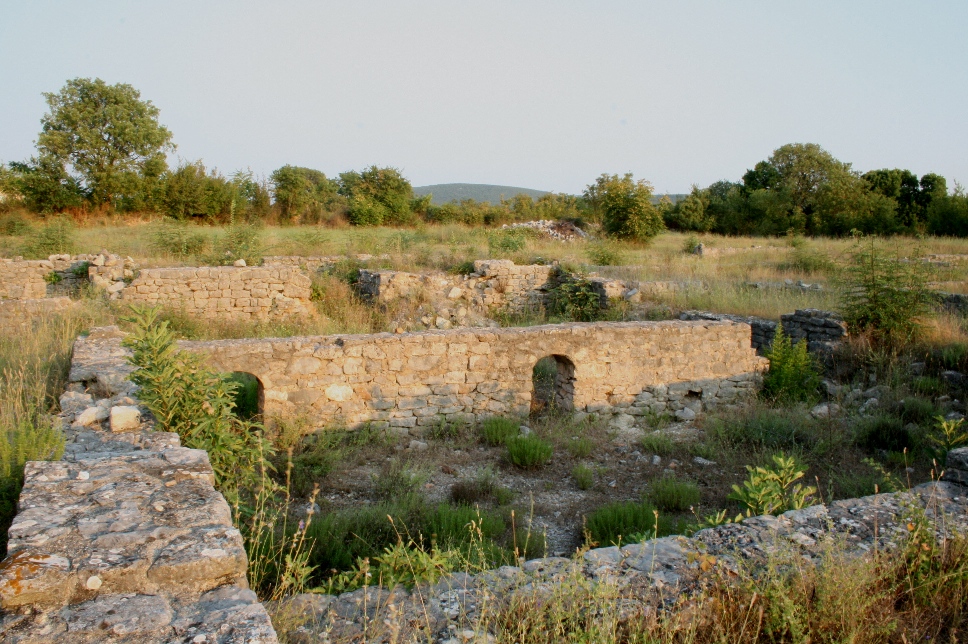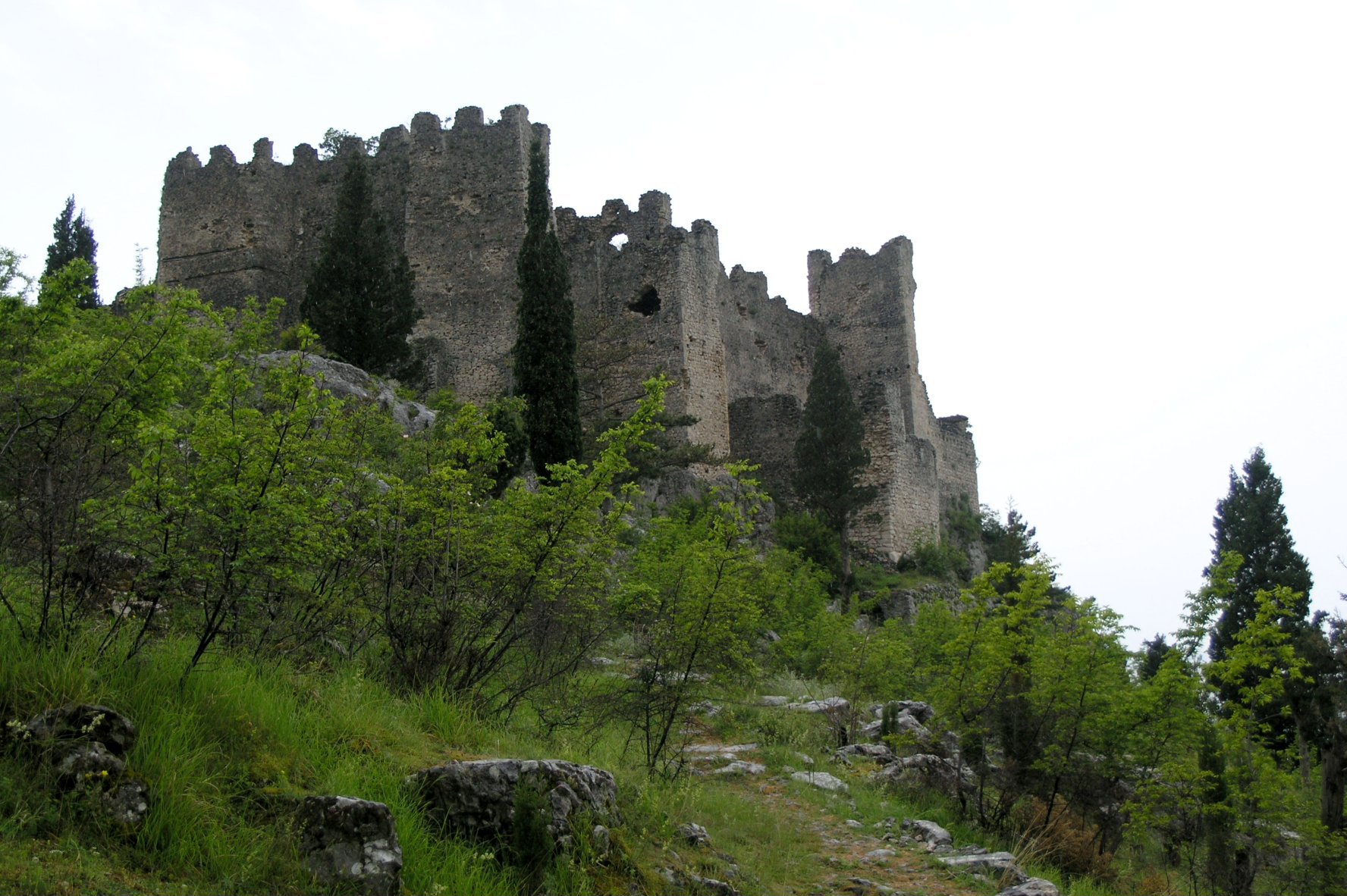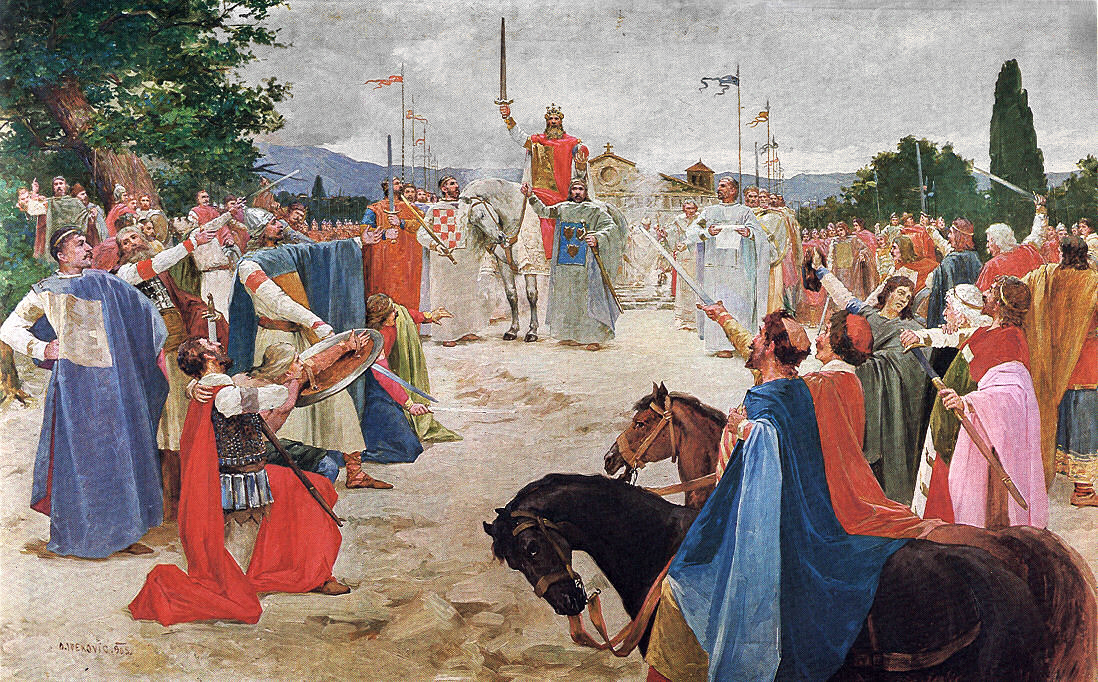|
West Herzegovina County
The West Herzegovina Canton ( hr, Županija Zapadnohercegovačka, bs, Zapadnohercegovački kanton) is one of the cantons of the Federation of Bosnia and Herzegovina. The West Herzegovina Canton is in the Herzegovina region in the southwest of Bosnia and Herzegovina. Its seat of government is in Široki Brijeg, while other municipalities within the Canton are Grude, Ljubuški and Posušje. It has 94,898 inhabitants, of whom more than 98% are ethnic Croats. History The majority of the present-day West Herzegovina Canton was part of Zachlumia, the medieval South Slavic principality. In the 15th century it became part of the Duchy of Saint Sava under Stjepan Vukčić Kosača, who proclaimed himself the herzog (duke), thus giving the name for the whole region - Herzegovina. The Ottomans conquered Herzegovina in 1483, when the territory of the West Herzegovina Canton became part of the Sanjak of Herzegovina. In 1833 the Sanjak of Herzegovina became more autonomous under Ali-paša R ... [...More Info...] [...Related Items...] OR: [Wikipedia] [Google] [Baidu] |
Cantons Of The Federation Of Bosnia And Herzegovina
The ten cantons of the Federation of Bosnia and Herzegovina, one of the two political entities of Bosnia and Herzegovina, are its federal units with a high level of autonomy. The cantons were established by the Law on Federal Units (Cantons) on 12 June 1996 as a result of the Washington Agreement of 1994 between the representatives of the Bosnian Croats and Bosniaks. Five of the cantons have a Bosniak majority: Una-Sana Canton, Tuzla Canton, Zenica-Doboj Canton, Bosnian-Podrinje Canton Goražde and Sarajevo Canton; three have a Croat majority: Posavina Canton, West Herzegovina Canton and Canton 10, and the two cantons are regarded as ethnically mixed: Central Bosnia Canton and Herzegovina-Neretva Canton. The most populous canton is Tuzla Canton, while Canton 10 is the largest by area. Creation The cantons of the Federation of Bosnia and Herzegovina are a result of an artificial application of 1993 Vance–Owen Peace Plan for the war in Bosnia and Herzegovina, applied only to ... [...More Info...] [...Related Items...] OR: [Wikipedia] [Google] [Baidu] |
Bosnia And Herzegovina
Bosnia and Herzegovina ( sh, / , ), abbreviated BiH () or B&H, sometimes called Bosnia–Herzegovina and often known informally as Bosnia, is a country at the crossroads of south and southeast Europe, located in the Balkans. Bosnia and Herzegovina borders Serbia to the east, Montenegro to the southeast, and Croatia to the north and southwest. In the south it has a narrow coast on the Adriatic Sea within the Mediterranean, which is about long and surrounds the town of Neum. Bosnia, which is the inland region of the country, has a moderate continental climate with hot summers and cold, snowy winters. In the central and eastern regions of the country, the geography is mountainous, in the northwest it is moderately hilly, and in the northeast it is predominantly flat. Herzegovina, which is the smaller, southern region of the country, has a Mediterranean climate and is mostly mountainous. Sarajevo is the capital and the largest city of the country followed by Banja Luka, Tu ... [...More Info...] [...Related Items...] OR: [Wikipedia] [Google] [Baidu] |
Herzegovina Eyalet
The Eyalet of Herzegovina ( ota, ایالت هرسك; Eyālet-i Hersek, sh, Hercegovački pašaluk) was an administrative division (''eyalet'') of the Ottoman Empire from 1833 to 1851. Its last capital was Mostar. History In 1831, Bosnian kapudan Husein Gradaščević occupied Travnik, demanding autonomy and the end of military reforms in Bosnia. Ultimately, exploiting the rivalries between beys and kapudans, the grand vizier succeeded in detaching the Herzegovinian forces, led by Ali-paša Rizvanbegović, from Gradaščević’s. The revolt was crushed, and in 1833, a new eyalet of Herzegovina was created from the southern part of the eyalet of Bosnia and given to Ali Agha Rizvanbegović as a reward for his contribution in crushing the uprising. This new entity lasted only for 18 years, that is, for the rest of Rizvanbegović's life: he was executed when the Porte discovered he was secretly building an independent power base. After Rizvanbegović's death, it was reintegrated ... [...More Info...] [...Related Items...] OR: [Wikipedia] [Google] [Baidu] |
Pasha
Pasha, Pacha or Paşa ( ota, پاشا; tr, paşa; sq, Pashë; ar, باشا), in older works sometimes anglicized as bashaw, was a higher rank in the Ottoman Empire, Ottoman political and military system, typically granted to governors, generals, dignitary, dignitaries, and others. As an honorific, honorary title, ''Pasha'', in one of its various ranks, is similar to a British Peerage of the United Kingdom, peerage or knighthood, and was also one of the highest titles in the 20th-century Kingdom of Egypt. The title was also used in Morocco in the 20th century, where it denoted a regional official or governor of a district. Etymology The English word "pasha" comes from Turkish language, Turkish ('; also ()). The Oxford Dictionaries (website), Oxford Dictionaries attributes the origin of the English borrowing to the mid-17th century. The etymology of the Turkish word itself has been a matter of debate. Contrary to titles like emir (''amīr'') and bey (''beg''), which were es ... [...More Info...] [...Related Items...] OR: [Wikipedia] [Google] [Baidu] |
Sanjak Of Herzegovina
The Sanjak of Herzegovina ( tr, Hersek Sancağı; sh, Hercegovački sandžak) was an Ottoman administrative unit established in 1470. The seat was in Foča until 1572 when it was moved to Taşlıca (Pljevlja). The sanjak was initially part of the Eyalet of Rumelia but was administrated into the Eyalet of Bosnia following its establishment in 1580. History 15th century In November 1481 Ayas, an Ottoman general, attacked Novi and captured it probably at the end of January 1482. The sanjak was established between 1483 and 1485. In 1485, Novi was established as a ''kadiluk'' of the sanjak of Herzegovina. 16th century In 1572, the seat of the sanjak was moved from Foča to Pljevlja. The Banat Uprising (1594) had been aided by Serbian Orthodox metropolitans Rufim Njeguš of Cetinje and Visarion of Trebinje (s. 1590–1602). In 1596 revolts spread into Ottoman Montenegro and the neighbouring tribes in Herzegovina, especially under influence of Metropolitan Visarion. A Ragusan ... [...More Info...] [...Related Items...] OR: [Wikipedia] [Google] [Baidu] |
Ottoman Empire
The Ottoman Empire, * ; is an archaic version. The definite article forms and were synonymous * and el, Оθωμανική Αυτοκρατορία, Othōmanikē Avtokratoria, label=none * info page on book at Martin Luther University) // CITED: p. 36 (PDF p. 38/338) also known as the Turkish Empire, was an empire that controlled much of Southeast Europe, Western Asia, and Northern Africa between the 14th and early 20th centuries. It was founded at the end of the 13th century in northwestern Anatolia in the town of Söğüt (modern-day Bilecik Province) by the Turkoman tribal leader Osman I. After 1354, the Ottomans crossed into Europe and, with the conquest of the Balkans, the Ottoman beylik was transformed into a transcontinental empire. The Ottomans ended the Byzantine Empire with the conquest of Constantinople in 1453 by Mehmed the Conqueror. Under the reign of Suleiman the Magnificent, the Ottoman Empire marked the peak of its power and prosperity, as well a ... [...More Info...] [...Related Items...] OR: [Wikipedia] [Google] [Baidu] |
Stjepan Vukčić Kosača
Stjepan Vukčić Kosača ( sr-Cyrl, Стјепан Вукчић Косача; 1404–1466) was the most powerful Bosnian nobleman whose active political career spanned the last three decades of medieval Bosnian history, from 1435 to 1465. During this period, three kings succeeded to the Bosnian throne, Tvrtko II, Thomas ''(Tomaš)'', Stephen Tomašević ''(Stjepan Tomašević)'', one anti-king, Radivoj, the older brother of King Thomas, and the county's fate was sealed by the Ottoman conquest. He was probably born in 1404, a son of the Knyaz of Drina, Vukac Hranić, and Katarina, whose ancestry is unknown. Stjepan's father's hereditary lands were in the Upper Drina region. A member of the Kosača noble family, he succeeded his uncle, Duke Sandalj, as duke of Humska zemlja and the Grand Duke of Bosnia, in 1435. None influenced the development of the late Bosnian medieval state as much as Stjepan Vukčić did. Supporting Radivoj in the line of succession for ... [...More Info...] [...Related Items...] OR: [Wikipedia] [Google] [Baidu] |
Duchy Of Saint Sava
Duchy of Saint Sava ( sr-Cyr, Војводство Светог Саве, Vojvodstvo Svetog Save) was a late medieval polity in southeastern Europe, that existed from 1448 up to 1482, when it was absorbed by the Ottoman Empire. It was ruled by the Kosača noble family, who held the title "Duke of Saint Sava" (Serbian Cyrillic: Херцег од Светог Саве / Herceg od Svetog Save). Their domains included southern parts of modern-day Bosnia and Herzegovina, extending to southern parts of modern-day coastal Croatia, northwestern Montenegro and southwestern Serbia. Its founder, Stjepan Vukčić Kosača (duke since 1448), titled himself Herceg of Saint Sava, a title which would later give rise to the new name to the region: Herzegovina, and will be also used by the Ottomans as ''Hersek Sancağı'' (Sanjak of the Herzeg), designating the Sanjak of Herzegovina. In various sources, and historiographical traditions, the name of the duchy is recorded or used in several forms ... [...More Info...] [...Related Items...] OR: [Wikipedia] [Google] [Baidu] |
South Slavs
South Slavs are Slavic peoples who speak South Slavic languages and inhabit a contiguous region of Southeast Europe comprising the eastern Alps and the Balkan Peninsula. Geographically separated from the West Slavs and East Slavs by Austria, Hungary, Romania, and the Black Sea, the South Slavs today include Bosniaks, Bulgarians, Croats, Macedonians, Montenegrins, Serbs, and Slovenes, respectively the main populations of Bosnia and Herzegovina, Bulgaria, Croatia, North Macedonia, Montenegro, Serbia, and Slovenia. In the 20th century, the country of Yugoslavia (from Serbo-Croatian, literally meaning "South Slavia" or "South Slavdom") united majority of South Slavic peoples and lands—with the exception of Bulgarians and Bulgaria—into a single state. The Pan-Slavic concept of ''Yugoslavia'' emerged in the late 17th century Croatia, at the time party of Habsburg Monarchy, and gained prominence through the 19th-century Illyrian movement. The Kingdom of Serbs, Croats and Slovenes ... [...More Info...] [...Related Items...] OR: [Wikipedia] [Google] [Baidu] |
Zachlumia
Zachlumia or Zachumlia ( sh-Latn-Cyrl, separator=" / ", Zahumlje, Захумље, ), also Hum, was a medieval principality located in the modern-day regions of Herzegovina and southern Dalmatia (today parts of Bosnia and Herzegovina and Croatia, respectively). In some periods it was a fully independent or semi-independent South Slavic principality. It maintained relations with various foreign and neighbouring powers (Byzantine Empire, First Bulgarian Empire, Kingdom of Croatia, Principality of Serbia) and later was subjected (temporarily or for a longer period) to Kingdom of Hungary, Kingdom of Serbia, Kingdom of Bosnia, Duchy of Saint Sava and at the end to the Ottoman Empire. Etymology Zachlumia is a derivative of ''Hum'', from Proto-Slavic '' *xŭlmŭ'', borrowed from a Germanic language (cf. Proto-Germanic '' *hulma-''), meaning ''"Hill"''. South Slavic ''Zahumlje'' is named after the mountain of Hum (za + Hum "behind the Hum"), above Bona, at the mouth of the Buna. The p ... [...More Info...] [...Related Items...] OR: [Wikipedia] [Google] [Baidu] |
Croats Of Bosnia And Herzegovina
The Croats of Bosnia and Herzegovina (), often referred to as Bosnian Croats () or Herzegovinian Croats () are the third most populous ethnic groups in Bosnia and Herzegovina, ethnic group in the country after Bosniaks and Serbs of Bosnia and Herzegovina, Serbs, and are one of the Constitutive nations of Bosnia and Herzegovina, constitutive nations of Bosnia and Herzegovina. Croats of Bosnia and Herzegovina have made significant contributions to the culture of Bosnia and Herzegovina. Most Croats declare themselves Catholic Church in Bosnia and Herzegovina, Catholics and speakers of Croatian language. From the 15th to the 19th century, Christianity in the Ottoman Empire, Catholics in Ottoman Bosnia and Herzegovina were often persecuted by the Ottoman Empire, causing many of them to flee the area. In the 20th century, political turmoil and poor economic conditions caused more to Emigration, emigrate. Ethnic cleansing in the Bosnian War, Ethnic cleansing within Bosnia and Herzegovi ... [...More Info...] [...Related Items...] OR: [Wikipedia] [Google] [Baidu] |





